- Joined
- Sep 4, 2013
- Messages
- 99
Having acquired my 1947 vintage Atlas TH42 some 30 years ago, when we were both a lot younger, I have recently added a new dimension of accuracy that I will share with you. DRO’s made from Harbor Freight digital calipers. First an overall picture of my pimped out TH42:
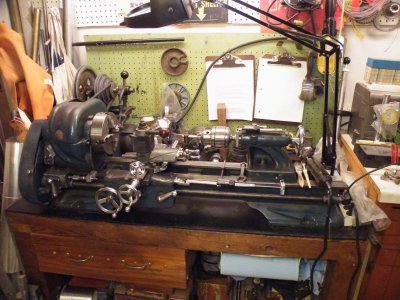
I found that Harbor Freight sold Chinese digital calipers for about $10 with a coupon. When one failed, I took it apart to see what was in it and how it worked. I also Googled them for a better explanation. After some study, I thought that they would still work if they were shortened, and so it turned out to be. The problem was, even shortened with a cutoff wheel in a Dremel tool, there was no way I could drill a hole in them since they are made from hardened steel.
I decided that the installation of the DRO’s would have to meet certain requirements. First, They had to be easily removable for repair, replacement, or if they got in the way for some reason. The removal of no more than 3 screws will release any of them. Then, there must be little or no changes to the TH-42. And the only thing that was a change was threading the oil hole in the tailstock. Also, the battery had to be accessible without removing the device. And I also didn't want the LCD screen to move.
I figured out that if I ground a small slot or semicircle in each side near the top, I could put a screw on each side pinning that end in place. The other end was secured by clamping the depth blade in place. The result was a fully functional DRO for $10. I soon cracked the glass on the DRO and I glued a piece of transparent plastic over the readout to protect it. Now for a look at the tailstock.
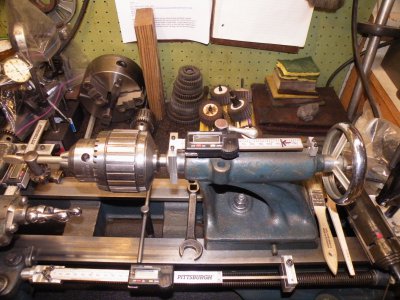
Note the oversized chuck, a Jacobs 18N ¾” Super Chuck. This enables me to use not only drills, but also milling cutters and reamers. In the event I need to handle smaller size, a Jacobs 14N stands ready for service. Now a closer look at the top of the tailstock:
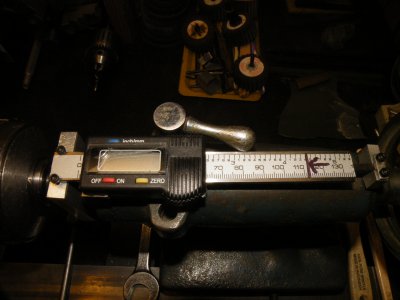
Note the DRO mounted on top which enables control of the ram to 0.001.” The black line with the arrow indicates the maximum extension of the ram.
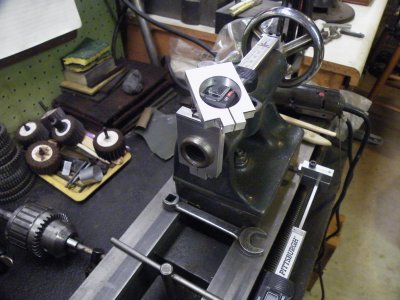
This view shows the clamp that goes on the front of the tailstock ram. There is a slit at the bottom and a clamp screw to tighten it and hold it in place. A ram clamp is placed on top for a better view.
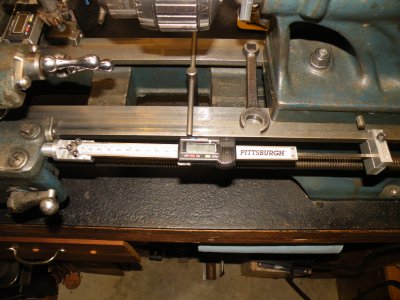
I decided that a DRO on the carriage would be nice, also. I never use the threading attachment, so there was a threaded hole ready for use. I made an aluminum cylinder with a steel screw to fit the hole and then threaded it in hand tight. I marked the top of the cylinder and machined a flat with the mill. I drilled 3 holes to correspond to three notches ground in the top end of the sliding ruler and a clamp for the depth blade that attached to the side of the bed.
The depth blade clamp has a notch milled in it to allow the tailstock adjustment screw to slide by if the tailstock is moved.
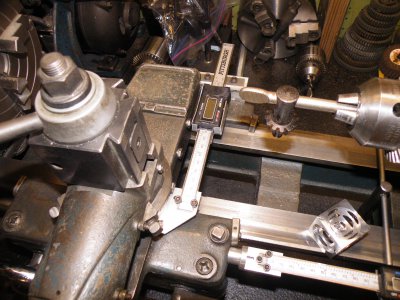
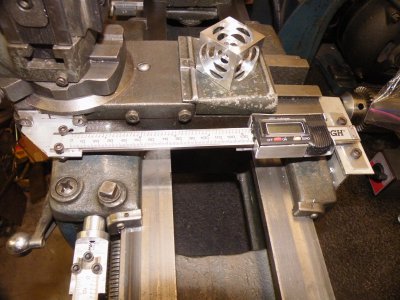
I have grown tired of trying to read and count the microscopic numbers and lines, so a DRO for the carriage cross slide was in order. This one presented some real problems for mounting since if I used the depth blade, the total length of the DRO when extended would have been about a foot. Instead I made a wrap around clamp out of sheet aluminum that held the LCD screen and held it over the far rail of the bed using some long gib screws I made and fastened in place with the gib screw nuts.. I made another bracket out of aluminum plate that held the sliding ruler to the carriage by using the gib screws and fastened it on with the gib screw nuts.
With these DRO’s in place I can move in increments of 0,001” and not be concerned about backlash since the DRO is indicating exactly what the movement is.
And last but not least:
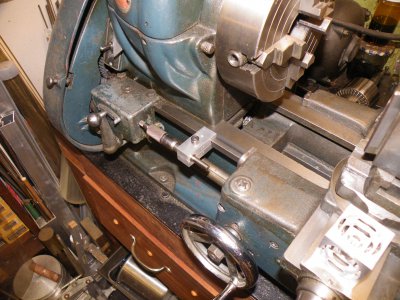
You might also notice the lamp with the magnifier that can be positioned over the chuck. Makes it so much easier to closely monitor the progress of a cut.
There is also a carriage stop mounted on the side of the bed rail. A Brown & Sharpe micrometer head is in a clamp that makes a micro-adjustable stop.
As an aside, my first project after these additions was a Turners Cube. I made a 3 level cube, and then the 4 level, just to prove I could really do it. At 71, and with no formal training at all, it was an accomplishment. I understand that is a graduation test for an apprentice. I now understand why there are so few of them out there for sale! Unless you have a CNC mill or lathe, they are just MUCH too time consuming to be worth making except to show you can do it.

I found that Harbor Freight sold Chinese digital calipers for about $10 with a coupon. When one failed, I took it apart to see what was in it and how it worked. I also Googled them for a better explanation. After some study, I thought that they would still work if they were shortened, and so it turned out to be. The problem was, even shortened with a cutoff wheel in a Dremel tool, there was no way I could drill a hole in them since they are made from hardened steel.
I decided that the installation of the DRO’s would have to meet certain requirements. First, They had to be easily removable for repair, replacement, or if they got in the way for some reason. The removal of no more than 3 screws will release any of them. Then, there must be little or no changes to the TH-42. And the only thing that was a change was threading the oil hole in the tailstock. Also, the battery had to be accessible without removing the device. And I also didn't want the LCD screen to move.
I figured out that if I ground a small slot or semicircle in each side near the top, I could put a screw on each side pinning that end in place. The other end was secured by clamping the depth blade in place. The result was a fully functional DRO for $10. I soon cracked the glass on the DRO and I glued a piece of transparent plastic over the readout to protect it. Now for a look at the tailstock.

Note the oversized chuck, a Jacobs 18N ¾” Super Chuck. This enables me to use not only drills, but also milling cutters and reamers. In the event I need to handle smaller size, a Jacobs 14N stands ready for service. Now a closer look at the top of the tailstock:

Note the DRO mounted on top which enables control of the ram to 0.001.” The black line with the arrow indicates the maximum extension of the ram.

This view shows the clamp that goes on the front of the tailstock ram. There is a slit at the bottom and a clamp screw to tighten it and hold it in place. A ram clamp is placed on top for a better view.

I decided that a DRO on the carriage would be nice, also. I never use the threading attachment, so there was a threaded hole ready for use. I made an aluminum cylinder with a steel screw to fit the hole and then threaded it in hand tight. I marked the top of the cylinder and machined a flat with the mill. I drilled 3 holes to correspond to three notches ground in the top end of the sliding ruler and a clamp for the depth blade that attached to the side of the bed.
The depth blade clamp has a notch milled in it to allow the tailstock adjustment screw to slide by if the tailstock is moved.


I have grown tired of trying to read and count the microscopic numbers and lines, so a DRO for the carriage cross slide was in order. This one presented some real problems for mounting since if I used the depth blade, the total length of the DRO when extended would have been about a foot. Instead I made a wrap around clamp out of sheet aluminum that held the LCD screen and held it over the far rail of the bed using some long gib screws I made and fastened in place with the gib screw nuts.. I made another bracket out of aluminum plate that held the sliding ruler to the carriage by using the gib screws and fastened it on with the gib screw nuts.
With these DRO’s in place I can move in increments of 0,001” and not be concerned about backlash since the DRO is indicating exactly what the movement is.
And last but not least:

You might also notice the lamp with the magnifier that can be positioned over the chuck. Makes it so much easier to closely monitor the progress of a cut.
There is also a carriage stop mounted on the side of the bed rail. A Brown & Sharpe micrometer head is in a clamp that makes a micro-adjustable stop.
As an aside, my first project after these additions was a Turners Cube. I made a 3 level cube, and then the 4 level, just to prove I could really do it. At 71, and with no formal training at all, it was an accomplishment. I understand that is a graduation test for an apprentice. I now understand why there are so few of them out there for sale! Unless you have a CNC mill or lathe, they are just MUCH too time consuming to be worth making except to show you can do it.
